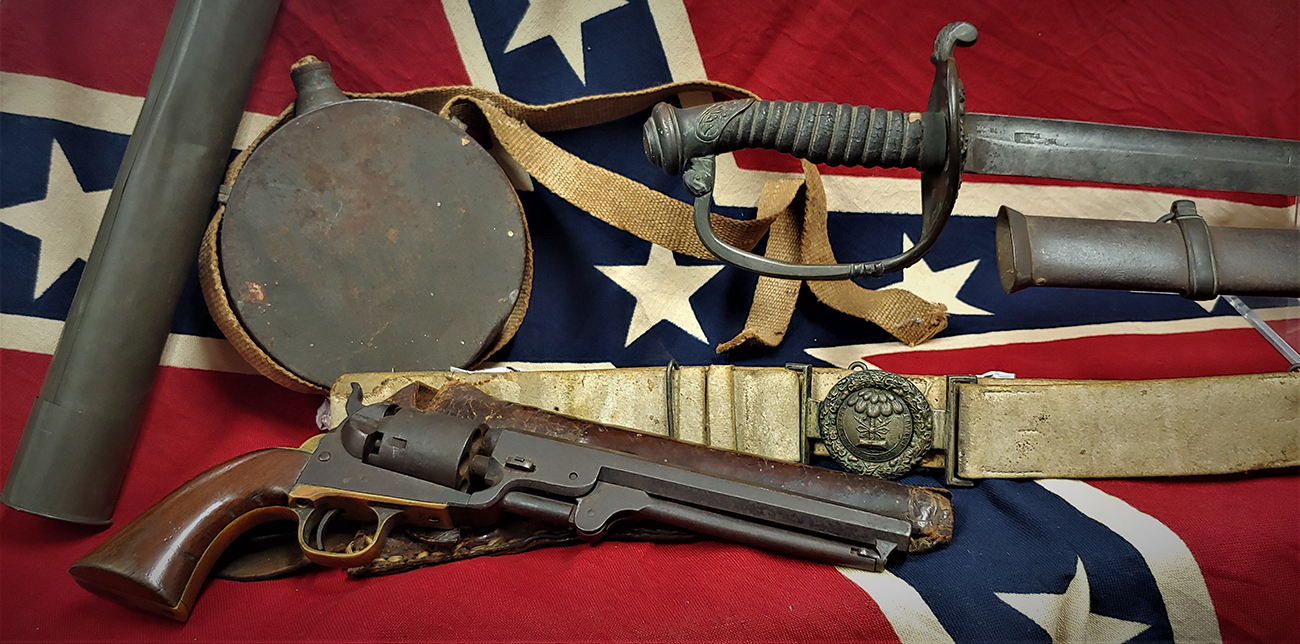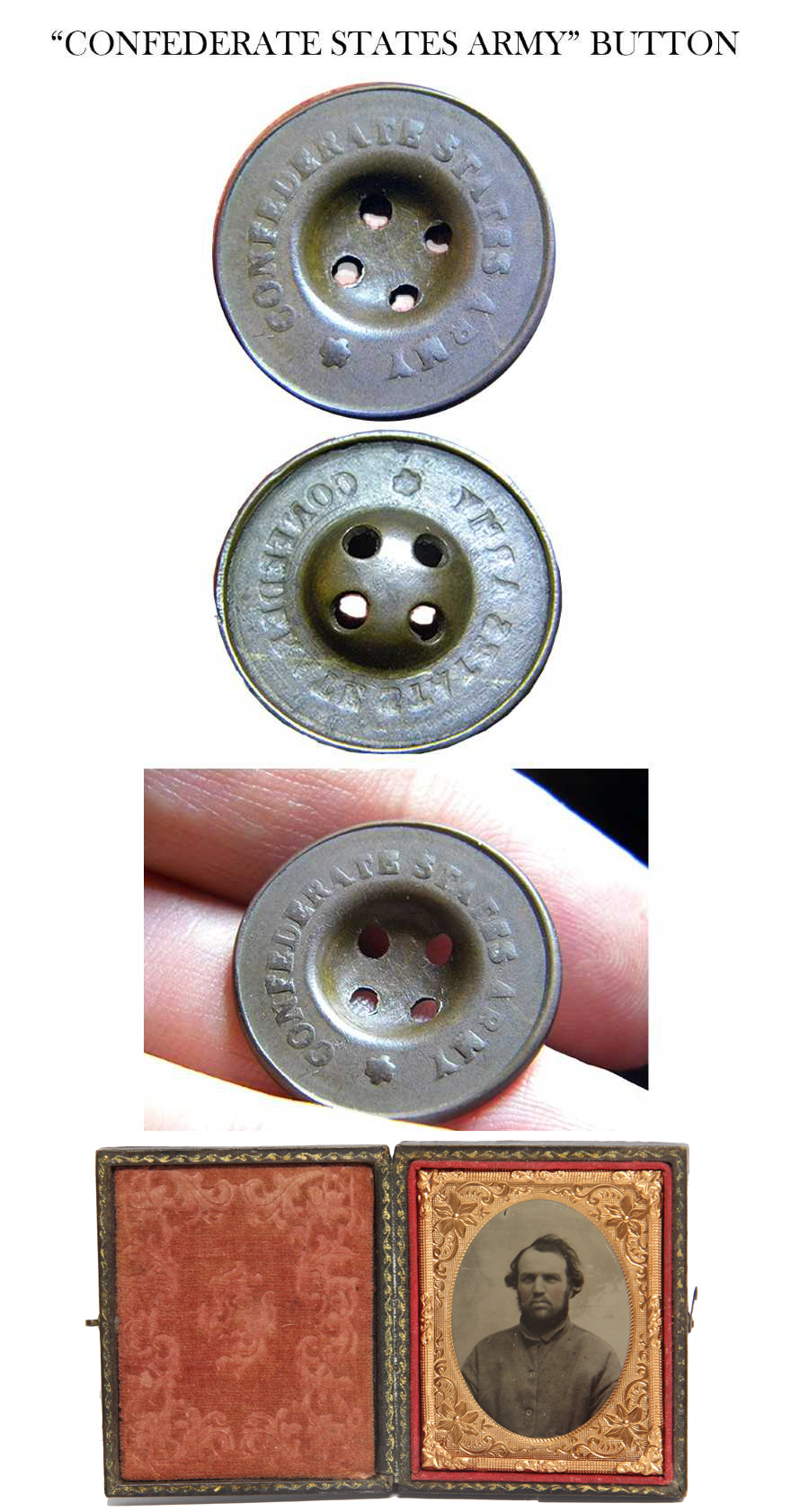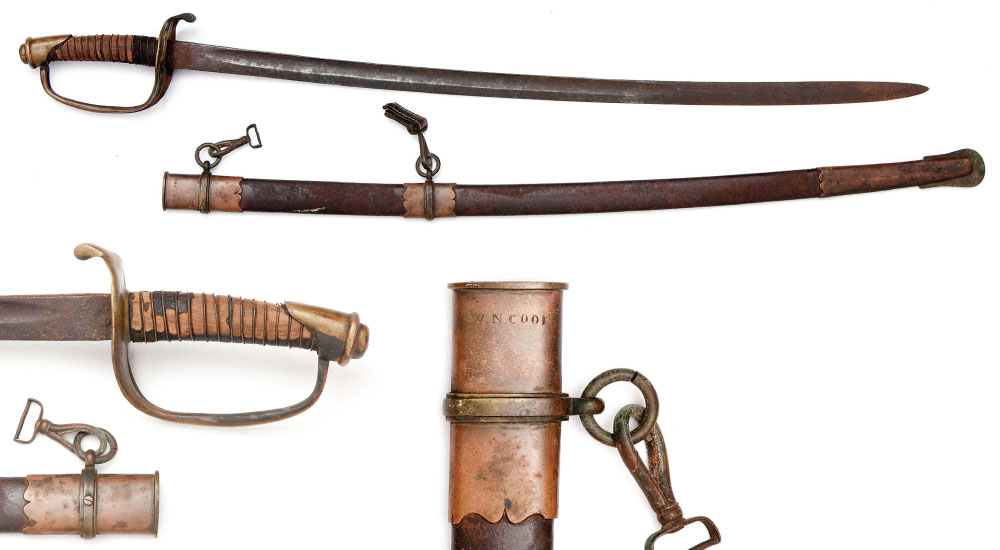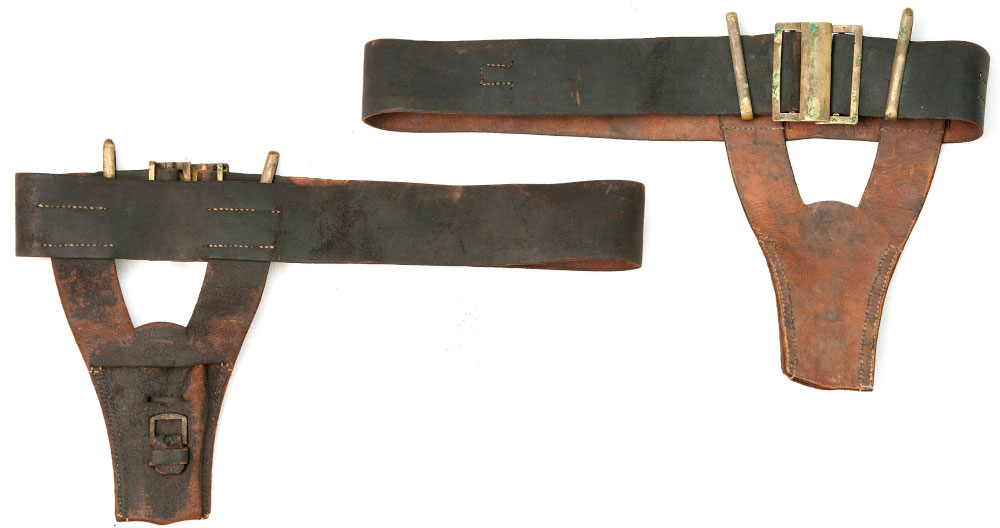Civil War Confederate Items
Capt. Thomas K Anderson South Carolina – CSA




SOUTH CAROLINA CONFEDERATE WEAPONS & EFFECTS OF CAPT. THOMAS KINCAID ANDERSON …I purchased this archive through a friend and fellow collector who was neighbors with the Great Great Grandaughter of T.K. Anderson. I made my check payable to Ms. Anderson when we consummated the deal. This grouping descended in the family until my purchase. They are a very prominent founding family of Fairfield County, SC, with roots going back to Colonial times. Accompanying this lot is the published history of the family with many entries on Thomas Kincaid Anderson and his connection to the Lost Cause. Typical large southern land owning families in the 18th century, had many family members involved in the militia starting with Cherokee Indian wars of the 1760s, Revolutionary War, War of 1812 where William Kincaid raised his own volunteer company. Several family members attended the Citadel including 2 of Thomas’ older brothers & a younger brother John who was killed near Atlanta August 31, 1864. Thomas was near his home when Sherman burned Columbia and was said to have buried the family silver & jewelry prior to Sherman’s “bummers” ransacking their stately home “House on the Rock” where this archive originated. The 100 page accompanying history is actually titled The House on the Rock. The U.S.C. Carolina Library has over 2500 family documents in the “Kincaid-Anderson” family papers which should be researched. The material offered here includes 1) An extremely rare KRAFT, GOLDSCHMIDT & KRAFT” staff officer’s sword with its’ original brass mounted steel scabbard and etched blade which includes the etched signature “S.C.” in a sunburst over the word “Columbia”. It was of course made in Columbia, SC; 2) South Carolina Officer’s Belt and Buckle A classic southern rig. The white buff belt is sound & solid with some soiling & staining & 2 spots of mouse chewing on the top edge. Buckle is truly fine, exquisite, retaining hints of gilt and rich age patina. NEVER been cleaned! The tongue is the die-stamped SC state seal. Tongue & wreath have matching assembly marks of “H” surrounded by 4 dots. Belt loops measure 51mm & is 89mm overall. 3) Well worn Confederate brown leather holster with a good Colt Navy revolver SN 184564 which was made in 1865; 4) Superb Confederate tin canteen with original Confederate woven linen sling. All these items have the same handsome “as found” appearance with undisturbed patina. CONDITION: The KG&K sword is in excellent “as found” condition with the richest and prettiest age patina you could hope to find. It has the standard 32″ single fullered blade. The blade etching is worn but still largely discernible. “SC” in a sunburst and “COLUMBIA” can still be easily observed on the ricasso, as well as a patriotic motif of crossed cannons further down the blade. The blade is overall gray steel showing wear and evidence of long ago sharpening. The original scabbard is outstanding with NO dents or dings. The brass throat, mounts, rings, and drag are excellent and retain 100% undisturbed 150 year old age patina. The grip retains its original leather and original twisted wire wrap. 3) Fourth model Colt Navy with all matching serial numbers. It exhibits a dark iron patina with strong traces of bright blue in protected areas. Brass trigger guard & backstrap have strong traces of original silver plate with overall mustard colored patina. Grips retain most of their original varnished finish. Capt. Anderson’s initials are neatly scratched on the butt strap “TA”. Revolver has very tight action, a little wobbly between bbl & frame. There are 7 notches cut in right grip. The original holster accompanying this gun is a typical plantation made flap holster with a brass finial. It is sound & supple retaining good color with scuffing & cracking with losses & several cracks at muzzle end. Holster was resewn during its time of service for continued use. How did Capt. Anderson end up with this revolver that was made in 1865? There were Union occupation troops for several years after the war & there was continued violence among Southern conservative organizations in “unredeemed” South Carolina til 1877 when occupation troops were finally removed ending reconstruction. Anderson’s obituary & tombstone state his name as Capt. Thomas Anderson. Despite loads of family biography I have not yet been able to determine Thomas Kincaid Anderson’s precise military designation. My feeling is that he may have been on staff duty, perhaps at the state level as opposed to Confederate Central Government. His obituary does state he was director of the State Penitentiary which was not far from the family home in Columbia. 4) Classic Confederate tin canteen measuring 6-1/8″ in diameter, 2″ wide with soldered tin spout, 3 tin loops with a classic Confederate woven linen sling that has separated at one spot. Also present is an 1 inch cylindrical tin document or map case with friction fit lid with Capt. Anderson’s son’s initials “EKA” scratched in the lid. Here is one heck of a spectacular Confederate lot. One of the best rebel groupings I have owned, and I am the first person to own it outside of the family. P.O.R.
Call us @ 419-842-1863

NEWLY DISCOVERED : CONFEDERATE STATES ARMY BUTTON: A long time collector/friend showed me this button a couple years ago and I’ve been pestering him to sell it to me ever since. Finally, this year in Denver he did. It is a heretofore unlisted Confederate uniform button as far as I can determine. It is rougly the size of a 25 cent piece (quarter) and made of stamped brass. (About the size of a large officer’s coat button.) It is struck using a die and counter die resulting in the nice embossed lettering shown on the face which reads ” CONFEDERATE STATES ARMY * ” in all capital letters. The form is very much like trouser buttons of the period, but larger. It is a button-jar find as opposed to a metal detector find and has never been in the ground. It has an attractive non-dug light age patina like an old copper penny. When this first surfaced we dilligently researched it and came up with “NOTHING” … “NADA”. Absolutely no other examples could be located, no dug examples, no non-dug examples, no reenactor examples, no Google images examples, and none of the button guys had ever seen one nor heard of one. This made me want it even more. Fast forward… Well now I have it, and am sharing it here on my web page. If you know something more about this please email or call. I will share any data that I receive. Not for sale at this writing. I spent too much time chasing it and researching it. I want to finish that job before I pass it on.
The tintype shown here is not connected with the button other than to illustrate this type of button in use on coats in the 1860s.
Call us @ 419-842-1863

13-11-29 … 13-09-49 Wonderful Early Georgia Confederate Artillery Shadow Box Relic Display: An honest, REAL, antique, Civil War Relics shadow box put together in the 1880s or 1890s … likely by a Confederate veteran. This surfaced at a Georgia flea market and was purchased by a Georgia friend of mine from a Georgia flea-marketeer. Until I got it, I don’t think it had ever been outside the state of Georgia. My friend sold it to me on one of his trips “up North” to visit his daughter in Michigan. Inside the frame is an artillery horse hames, an iron artillery hammer, a military horse bit, a crude spur, and a crude and heavy picket pin that is designed to pound into a tree instead of the ground. (I found a similar rebel picket pin on the following relic page http://lookoutmountaincivilwarrelics.com/miscellaneous-items.html ) All the relics in this shadow box appear to be Confederate pieces. Best part is the large, original ancient Brown Ink label which at one time read “Confederate Artillery Hames”… Worst part is that portions of the label are missing so we actually see Conf—— Artillery H-mes”. This is the real-deal. A southern made relic display full of southern relics. This item will require special shipping or arrangements for delivery or pick-up. A wonderful early lot of Rebel Relics … $1,650.00
Call us @ 419-842-1863

#114 – Atlanta Georgia Confederate Officer’s Inscribed Sword: Fresh from an estate in north Georgia is this wonderful “as found” Confederate officer’s sword. It is a Boyle & Gamble Confederate foot officer’s sword made in Richmond, Virginia … housed in a captured Union scabbard. The age, color, patina, and rust are IDENTICAL on both the sword and scabbard. I repeat, the age, color, patina, and rust patterns are absolutely identical on both pieces. There is no question these two pieces have been together since the Civil War. Neatly and simply engraved on the top mount of the scabbard is “W. N. Cook”. Careful and deliberate research indicates that the owner of this sword is 2nd Lieutenant W. N. Cook of Campbells Light Artillery (Georgia) which served at the Confederate Arsenal in Atlanta. Using the U.S. National Park Service data base we find that of the hundreds of Confederates named “Cook” only two carry the initials “W.N.” One was a private in the 18th Georgia Infantry. The other is our artillery officer. Further research to rule out federal usage shows only one US officer named W N Cook in the war. He served less than a month in 1862 and died before ever leaving New Hampshire. This is fresh to the market. I bought it at our last meeting of the OGCA from the militaria dealer who obtained it from the first picker in Georgia. This is dead real and as honest as any sword you can find. The CS Artillery unit served as guards at the Atlanta Arsenal as far as I can determine. Perhaps you can learn more. The brass guard and brass scabbard mounts are beautifully patinated. The steel sheath and some spots on the blade have ancient rust and some light scale (identical on both). The grip has 70% of the leather covering worn away. The balance of the leather is dry and untouched. The single strand copper wire is still firmly in place. Still dangling from the ring mounts are brass clips off a sword belt. A really appealing Johnny Reb sword…. $5,950.00 SOLD
Call us @ 419-842-1863

#116 – US Model 1855 Rifleman’s Belt and Bayonet Frog with four piece buckle. Purchased by an old time collector from Bannerman’s in the 1940s, they advertised it as a “Confederate Army Officer’s Sword Belt” way back when. This is a VG+ black harness leather example. 100% complete except for the short tab on the frog that secures to the buckle. These were issued with Model 1855 rifles and other two-band short rifles that accepted the saber bayonet. The buckle is rather ingenious having the central interlocking buckle and then two flanking devices designed to hold the brass hooks of a knapsack. Overall VG to fine condition, just being a little dirty from years of storage. The tourist town dealers have been pricing these in the $1300 to $1600 range… Here is a heck of a deal…. $975.00 SOLD
Call us @ 419-842-1863
Previously Sold Items
#112 – Confederate 2-Piece Interlocking CS Sword Belt Plate (with or without the belt): This buckle is an extremely rare item to find in “non-dug” condition. This one is a spectacular Virginia pattern interlocking tongue and wreath buckle designed for use on a sword belt worn by officers or mounted troops. It is the pattern with attractive rounded serifs on the letters and a beautiful oak leaf decorated wreath. This design is figure 015 in Steve Mullinax’ book Confederate Belt Buckles and Plates. This one turned up at an estate auction in Northern Virginia in 2008 and was sold to me by the man who got it there this year (2010). He just couldn’t bring himself to sell it for a couple years. It is in perfect non-dug condition just as it was saved by the Virginian who wore it. It is shown here displayed on a belt I have owned for years— a beautiful brown leather sword belt that had no buckle on it when I got it. I do not know whether the belt originally had a militia buckle or Confederate buckle on it during the Civil War. I have simply kept it as one of the best examples of such a belt I have found. The keeper stitching is popped on the leather allowing for any two piece buckle to be displayed there. The CS buckle displayed on this belt it makes it look like a twenty thousand dollar rig, which it would be if the buckle had come on the belt and was held in place by original stitching. If you would like to have the belt to accompany the plate I will sell the belt with the buckle for $7,500.00 If you want just the buckle alone the price is $4,500.00 … SOLD
#115 – Identified Twice-Wounded Confederate Officer’s Boyle and Gamble staff sword and the Colt 1851 Navy revolver of the twice-captured Yankee who brought it home as a souvenir! I personally purchased these items directly from the family of James D. Gage, 1st R.I. and 1st N.H. Cavalry: Confederate Boyle and Gamble officer’s sword of Capt. Mallory L. Henley, 35th North Carolina Infantry and Gage’s own 1851 Colt Navy- relics of two early war volunteers on opposite sides who rose from enlistedmen to officers.
Gage enlisted at 20 in Manchester, NH, 10/1/61 and mustered into Co. K, First New England Cavalry 10/24/61, which was redesignated the First Rhode Island Cavalry in 1862, to the chagrin of the four New Hampshire companies forming its Third Battalion. He made Corporal 12/31/61. In May, 1862, his battalion made a celebrated charge on Confederate cavalry, infantry, and artillery holding the town of Front Royal, capturing 117 Confederates and freeing a number of Union prisoners. Gage was sick in hospital on 6/15/62, but returned 8/15/62 in time for Pope’s Virginia campaign, in which the regiment took part in all engagements. On 3/17/63 at Kelly’s Ford, “the first cavalry fight of the war,” in the face of enemy fire the regiment successfully charged across the river where another regiment had been repulsed. They then took part in the back and forth charges of the battle, losing 16 men captured who, “charged too far into the enemy’s lines.” Gage was apparently one of them, being listed as captured, but he was apparently resourceful: he is listed as having escaped the same day. During the Gettysburg campaign, the regiment fought Stuart’s cavalry at Middleburgh, Va, 6/18/63. Having barricaded themselves inside the town, they repulsed several assaults, but without reinforcements had to cut their way out. 200 were captured, including Gage, who was paroled 10/15/63. In January, 1864, the third battalion of the 1st R.I. Cav. was detached to form the nucleus of the 1st N.H. Cav. Gage transferred as of 1/7/64, with a promotion to Sergeant dated 1/5/64, and First Sergeant 7/1/64. The regiment fought at White Oak Swamp, Reams Station, and the Weldon Railroad, but saw most of its action in the Shenandoah at Winchester, Kearneysville, Tom’s Brook and two dozen other fights. Gage apparently took an active role and was well thought of, for he was commissioned (though not mustered) 2nd Lieutenant 6/10/65. He mustered out 7/15/65 at Clouds Mills, Va. Obituaries suggest Gage was also wounded several times during the war, though the readily available rosters do not show it, which is not unusual. After the war he was involved with the reburial of Union war dead in national cemetaries and eventually became the Adjutant-General of the State of Nebraska with the rank of Brigadier General in the national guard. Gage chose an interesting sword to keep as a souvenir of the war. Absolutely dead real is the name carved into the leather scabbard: M.L. HENLEY. The ONLY Confederate office this could be is Mallory L. Henley, 16th and the 35th North Carolina. (There isn’t even another plain “M. Henley.”) Henley resided in Henderson County when he enlisted at 22 on 5/5/61 and mustered as a private into Co. I of the 16th NC Infantry. This regiment served in Whiting’s, later A.P. Hill’s, division. Henley was wounded in the arm 5/31/62 at Seven Pines, Va., otherwise known as the first days fighting at Fair Oaks, where the regiment was heavily engaged.
Previously Sold Civil War Confederaye Items
The regiment also suffered heavily at Mechanicsville, Gaines Mill, Second Manassas and a number of other engagements. Henley was well enough regarded that he was offered and accepted a commission in the 35th North Carolina 10/7/62. He is listed as going into the regiment as a sergeant, but is immediately promoted 2nd Lieutenant and then 1st Lieutenant five days later, 10/12/62.
During Henley’s service with it the 35th served in Ransom’s Brigade in the Army of Northern Virginia, and then was posted to the Dept. of North Carolina and South Virginia. It served briefly in the Dept. of Richmond, from July to Sept. 1863, and returned further south until October 1864 when it rejoined the Army of Northern Virginia. The regiment fought at Fredericksburg, Kinston, NC, Plymouth, Bermuda Hundred, Petersburg, and Ft. Stedman. During the Petersburg campaign it lost men almost daily. CWData lists an astounding 124 dates where they suffered combat losses. Henley is listed as hospitalized with his second gunshot wound, this time to the left foot, on 5/19/64. Judging from the date, he is likely to have been wounded at Drewry’s Bluff or Bermuda Hundred. While recuperating he received a commission as Captain 6/25/64, and he returned to duty with the regiment 7/24/64 at Petersburg. His date and method of discharge are not given. Gage’s pistol is a Colt 1851 navy, serial #138769, thus made in early 1863. In all likelihood this is the pistol issued to him upon his return from parole in October, 1863, and would have seen action in the Shenandoah and elsewhere. The pistol has minor wear to the bottom edges of the grips. The only defects a missing forward screw in the trigger guard and a broken loading lever latch. Otherwise NRA “very good” condition being all original and unaltered. Confederate Henley’s sword is the classic Boyle and Gamble staff and field officer’s sword with the star over CS in a wreath in the brass guard, complete and unmessed with. The grip is nice, with full leather, though lacking the wire. The quillon has a slight downward curve, typical of a sword with some use. The blade is a characteristically Boyle and Gamble unetched blade with an unstopped fuller. The blade is mixed gray and bright with no pitting, rust or edge nicks. It even retains its washer at the blade shoulder under the guard. The scabbard is the typical top-stitched brass-mounted black leather with “M.L. HENLEY” neatly carved in block letters inside a rectangular border between the upper and middle mounts. Two small holes were punched in the middle mount for rivets that are now gone. Likewise a small pin secures the drag. The drag shows the wonderful wear along its bottom edge that we like to see on an actually field used sword from its contact with the ground. This is the classic, most sought, of all Confederate officer’s swords. This is a great set of weapons, the type that practically never shows up any more. Most families long ago parted with granddad’s old revolver, let alone a sword with a non-family member’s name on it, and most dealers would split this set up. Here’s a chance to own an intact historical family group that embodies everything- cavalry, infantry, north, south, officer and enlisted. A value at $22,500.00 … SOLD
Layaways are Welcome
Need to split your order into multiple payments? No problem! A simple 20% earnest money deposit will hold your item for you.-acf
You can then pay it off in easy installments that fit your budget.
Read Terms Here
Items to Sell? Contact Us
I am always interested in buying ANYTHING from the American Civil War… Guns, Swords, Civil War Muskets, Knives, Uniforms, Flags, Medals, Badges, Diaries, Letters, Autographs, Buttons, photographs, tintypes, daguerreotypes, Insignia, Camp Items, Battlefield Relics, canteens, Drums, Etc… Call 419-842-1863 and ask for Dave Taylor.



